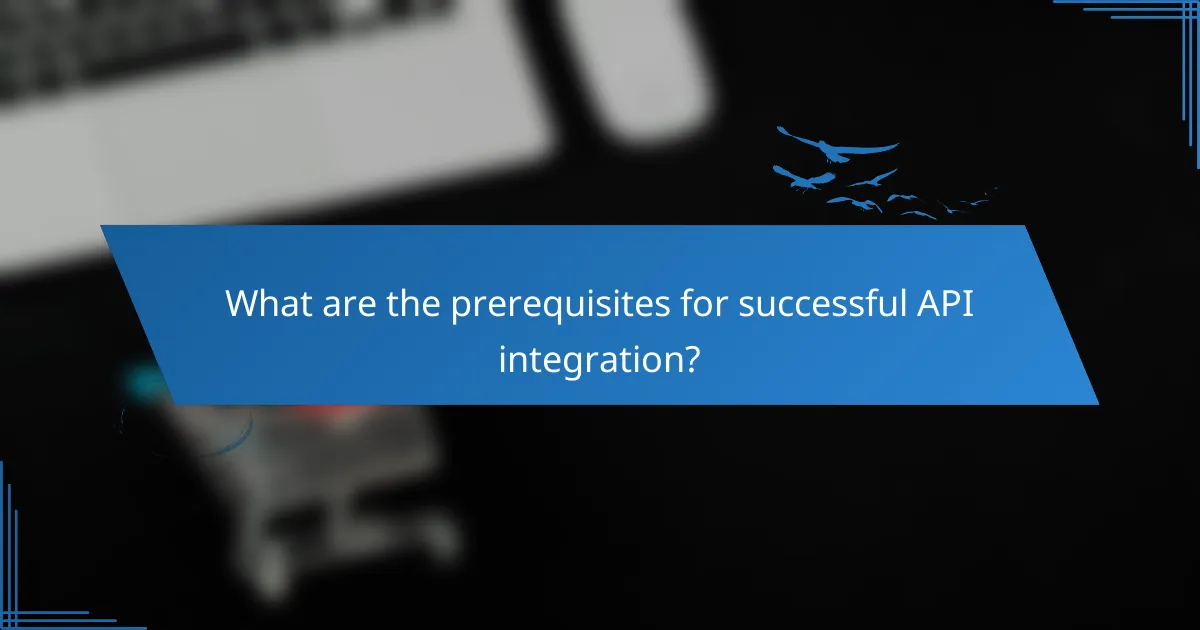API integrations play a crucial role in enhancing social media strategies by automating workflows, improving analytics, and facilitating seamless content management. By connecting various platforms, these integrations enable businesses to operate more efficiently and make informed decisions based on real-time data insights.

How can API integrations enhance social media strategy?
API integrations can significantly enhance social media strategies by automating processes, improving analytics, and streamlining content management. These integrations allow businesses to connect various platforms, enabling more efficient operations and better decision-making based on data insights.
Increased automation
API integrations facilitate increased automation by connecting social media platforms with other tools, such as customer relationship management (CRM) systems and marketing software. This automation can handle repetitive tasks like posting content, responding to messages, and tracking engagement metrics without manual intervention.
For example, businesses can set up automated posting schedules that align with peak engagement times, ensuring content reaches the audience when they are most active. This saves time and allows teams to focus on strategy rather than routine tasks.
Improved data analytics
Integrating APIs enhances data analytics by consolidating data from multiple sources into a single dashboard. This provides a comprehensive view of social media performance, allowing businesses to analyze engagement rates, audience demographics, and campaign effectiveness more effectively.
By leveraging these insights, companies can make data-driven decisions to refine their strategies. For instance, they can identify which types of content resonate most with their audience and adjust their approach accordingly, leading to improved engagement and conversion rates.
Streamlined content management
API integrations streamline content management by allowing businesses to publish and manage content across various social media platforms from a single interface. This reduces the complexity of managing multiple accounts and ensures consistency in messaging and branding.
Using tools that integrate with APIs, teams can easily schedule posts, monitor interactions, and respond to comments in real-time. This not only enhances efficiency but also helps maintain a cohesive brand presence across different channels.

What are the best API integrations for social media?
The best API integrations for social media enhance functionality, streamline processes, and improve engagement. Popular options include Hootsuite, Buffer, and Zapier, each offering unique features that cater to different social media management needs.
Hootsuite API
The Hootsuite API allows users to manage multiple social media accounts from a single platform. It provides functionalities such as scheduling posts, tracking engagement metrics, and analyzing performance across various channels.
When using the Hootsuite API, consider its integration capabilities with other tools like CRM systems or analytics platforms. This can help create a more cohesive marketing strategy. Ensure you adhere to Hootsuite’s rate limits to avoid disruptions.
Buffer API
Buffer’s API focuses on simplifying the scheduling and publishing of social media content. It enables users to automate posts across different platforms and analyze the effectiveness of their content.
Key features include the ability to customize posting schedules for each social media account and access to performance analytics. Users should be mindful of Buffer’s pricing tiers, which vary based on the number of accounts and features available.
Zapier API
Zapier API connects various applications to automate workflows, making it easier to manage social media tasks. It allows users to create “Zaps” that trigger actions across different platforms based on specific events.
For instance, you can set up a Zap to automatically share new blog posts on your social media accounts. Be cautious with the number of tasks per month, as exceeding limits may incur additional costs. This integration is particularly useful for businesses looking to streamline their marketing efforts without extensive coding knowledge.

How do API integrations improve functionality?
API integrations enhance functionality by enabling different software systems to communicate seamlessly, allowing for improved data exchange and operational efficiency. This connectivity facilitates real-time updates, cross-platform compatibility, and enhanced user engagement, which are crucial for modern social media strategies.
Real-time updates
Real-time updates are a significant advantage of API integrations, allowing platforms to share information instantly. For instance, when a user interacts with a post on one social media site, that action can be reflected across other connected platforms immediately, keeping all data synchronized.
This feature is particularly beneficial for businesses that rely on timely information, such as news outlets or e-commerce sites. Implementing APIs that support webhooks can ensure that updates occur without delay, enhancing the user experience and operational responsiveness.
Cross-platform compatibility
Cross-platform compatibility ensures that applications can work together regardless of their underlying technology. API integrations facilitate this by providing a standardized method for different systems to communicate, making it easier for businesses to reach users across various social media channels.
For example, a marketing tool can integrate with multiple social media platforms, allowing users to manage campaigns from a single interface. This reduces the need for multiple logins and streamlines workflow, ultimately saving time and resources.
Enhanced user engagement
Enhanced user engagement is achieved through API integrations that allow for personalized experiences. By leveraging data from various sources, businesses can tailor content and interactions to meet the specific preferences of their audience, increasing the likelihood of user interaction.
For instance, integrating APIs that analyze user behavior can help companies send targeted notifications or offers based on individual activity. This level of personalization can significantly boost engagement rates, leading to higher conversion and retention rates.

What are the prerequisites for successful API integration?
Successful API integration requires a combination of technical expertise, clear objectives, and a robust infrastructure. These elements ensure that the integration process is efficient, effective, and aligned with business goals.
Technical expertise
Having technical expertise is crucial for successful API integration. This includes knowledge of programming languages, data formats like JSON or XML, and understanding how APIs function. Teams should be proficient in using tools and frameworks that facilitate integration.
Consider hiring or training staff who are familiar with API documentation and can troubleshoot issues that arise during the integration process. A solid grasp of security protocols is also essential to protect sensitive data during API interactions.
Clear objectives
Establishing clear objectives is vital for guiding the API integration process. Define what you aim to achieve, such as improving user engagement on social media platforms or automating data sharing between systems. Specific goals help in selecting the right APIs and measuring success.
Communicate these objectives across your team to ensure everyone is aligned. Regularly revisit and adjust these goals based on performance metrics and changing business needs to maintain focus and effectiveness.
Robust infrastructure
A robust infrastructure supports seamless API integration. This includes having reliable servers, sufficient bandwidth, and a scalable architecture that can handle increased loads as your user base grows. Ensure that your systems can accommodate the data flow from the APIs without bottlenecks.
Regularly assess your infrastructure for weaknesses and invest in upgrades as necessary. Implementing monitoring tools can also help detect issues early, ensuring that your API integrations remain functional and efficient over time.

What criteria should be considered when selecting an API?
When selecting an API, consider factors such as scalability, security features, and the quality of support and documentation. These criteria will help ensure that the API meets your current needs while allowing for future growth and maintaining data integrity.
Scalability
Scalability refers to the API’s ability to handle increasing amounts of work or its potential to accommodate growth. An API should support a growing number of requests without significant performance degradation. Look for APIs that can manage load balancing and offer options for horizontal scaling.
For example, if your application is expected to grow from hundreds to thousands of users, choose an API that can seamlessly scale up its resources. Evaluate whether the API provider has a track record of handling high traffic and if they offer tiered pricing plans that align with your growth projections.
Security features
Security features are crucial when selecting an API to protect sensitive data and ensure compliance with regulations. Look for APIs that implement strong authentication methods, such as OAuth or API keys, and provide encryption for data in transit and at rest.
Additionally, consider whether the API provider adheres to industry standards and regulations, such as GDPR or CCPA, especially if you handle personal data. Regular security audits and vulnerability assessments are also indicators of a reliable API provider.
Support and documentation
Quality support and comprehensive documentation are essential for successful API integration. Ensure that the API provider offers accessible documentation, including clear examples, use cases, and troubleshooting guides. This will facilitate a smoother implementation process and help your team resolve issues quickly.
Evaluate the support options available, such as live chat, email, or phone support. A responsive support team can significantly reduce downtime and enhance your overall experience with the API. Look for user reviews or testimonials to gauge the effectiveness of the support provided.

How can businesses measure the success of API integrations?
Businesses can measure the success of API integrations by analyzing various metrics that reflect performance, user satisfaction, and financial impact. Key areas to focus on include engagement metrics, return on investment (ROI) analysis, and user feedback.
Engagement metrics
Engagement metrics provide insights into how users interact with the integrated API features. Key indicators include the number of active users, session duration, and frequency of interactions. For example, tracking the increase in user sessions after implementing a social media API can reveal its effectiveness.
Consider using tools like Google Analytics or social media insights to gather data on user engagement. Aim for a consistent increase in these metrics over time to indicate successful integration.
ROI analysis
ROI analysis helps businesses determine the financial benefits of API integrations compared to their costs. To calculate ROI, compare the revenue generated through the API features against the expenses incurred for development and maintenance. A positive ROI indicates that the integration is financially viable.
When assessing ROI, consider both direct revenue and indirect benefits, such as improved customer retention or reduced operational costs. A typical benchmark for a successful API integration might be achieving an ROI of at least 20% within the first year.
User feedback
User feedback is crucial for understanding the effectiveness of API integrations from the customer’s perspective. Collect feedback through surveys, reviews, or direct communication to gauge user satisfaction and identify areas for improvement. Positive feedback can validate the success of the integration, while negative feedback highlights potential issues.
Encourage users to provide feedback regularly, especially after major updates or changes. This ongoing dialogue can help businesses adapt their API strategies to better meet user needs and expectations.
